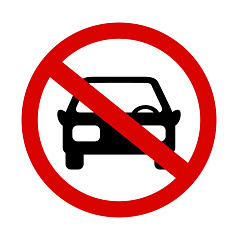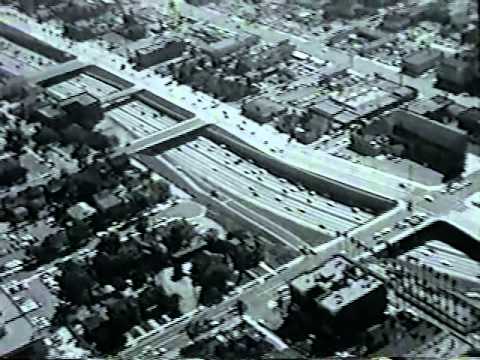In 1922, only one American in ten owned an automobile. (Everyone else used rail.) At that time Alfred P. Sloan (President, General Motors) said, ‘Wait a minute, this is a great opportunity. We’ve got 90 percent of the market out there that we can somehow turn into automobile users. If we can eliminate the rail alternatives, we will create a new market for our cars. And if we don’t, then General Motors’ sales are just going to remain level.’
Sloan wanted to get in very big in this field. What he bought was phenomenal: the largest bus-operating company in the country and the largest bus-production company. And using that as a foothold, GM moved into Manhattan. They acquired interests in the New York railways and between 1926 and '36 they methodically destroyed the rails.
When they finally motorized New York, General Motors issued ads throughout the country […] trying to show that motorization is the wave of the future. They issued these ads and they said, `The motorization of 4th and Madison is the most important event in the history of community transportation.’
GM worked hard to create the impression of a nationwide trend away from rail. But there was no trend. Buses were a tough sell. They jolted. They smelled. They inched through traffic. City by city, it took the hidden hand of General Motors to replace streetcars with Yellow Coach buses.
In 1936, a company was founded that would grow to dominate American city transportation. National City Lines had no visible connection to General Motors. In fact, the director of operations came from a GM subsidiary, Yellow Coach, and members of the Board of Directors came from Greyhound, which was founded and controlled by General Motors.
Over the next few years, Standard Oil of California, Mack Truck, Phillips Petroleum and Firestone Tire would join GM in backing this venture.
“They don’t take the service out, they just cut it back. They’ll take and cut it from 10 minutes to 12 minutes, from 12 to 15, from 15 to 20, from 20 to 30. So they reduce the service. And every time you reduce the service you make it less attractive. And the less attractive the fewer riders. And then they say, `Well see, we can’t make any money.’ So they abandon it.”
Narrator: Edwin Quinby was a rail buff with a talent for financial sleuthing. In 1946, he mailed a warning to influential people in hundreds of cities across the country. His 33-page broadside was filled with surprisingly detailed research. It brought to light what GM had worked hard to hide.
Edwin Quinby (voice over): “The plan is to destroy public utilities, which you’ll find impractical to replace after you discover your mistake. Who are the corporations behind this? Why are they permitted to destroy valuable electric railways?”
Mass Transportation Magazine (voice over): “Queer Case of Quinby, by Ross Schram. Edwin J. Quinby took full advantage of the great American privilege of the free press to feed the lunatic fringe of radicals and crackpots springing up like weeds in the United States today.”
National City Lines, General Motors and the other defendants were found guilty of conspiracy to monopolize the local transportation field.
“These companies, that had probably eliminated systems that in order to reconstitute today [1996] would require maybe $300 billion, these companies were individually fined $5,000.”
Narrator: The Justice Department would spend the next 25 years trying to limit GM’s influence on transportation. It would begin three major investigations into monopoly practices: two were settled out of court; one was eventually dropped. An effective way to rein in GM was never found.
Damn. Fuck GM. They took a functioning system not driven by profit and said we can’t have that, we need to be making money on this. Almost a century later and we still don’t have the same level of public transit most places
You can’t examine transportation policy in the US without including energy industry. You can’t isolate GM and be laundering Ford Chrysler Am.Motors as angels (and a few others in the further distant past also part of the gang). As long as there was a UAW in existence those gangsters were forced to unite for survival. No, I’m not trying to glorify UAW but you can’t speak of policy and auto-industry without them, I think.
In later stage development (post ww2), beyond auto and oil, there was the defense industry, which also played a role in undermining public transport.
The grand illusion liberals would have is that the role of gov. would be to find ways to shape transport policy as to minimize energy use, make things more efficient, make transport of people and commodities more efficient. In the US in particular this was never an intention and when there were such fools in power lobbyists were there to bring them back to their senses and what the real goal is; consumption!
The car is secondary to freight transport stupidity, the train was intentionally undermined in the US to project the truck. A train carrying freight uses nearly 1/8 the oil, and maybe 1/10 the labor needed. What’s the profit in that?
How can you then speak of transport policy just by examining auto-oil-defense industries and leaving urban planning out. Compare a German city to a post ww2 US city. No public transport system can really serve a US city/suburbia. It is chaotic. Manufacturing, office, storage, housing in all corners and directions and everything spread out to non-walkable daily distances. Who wants to get out of work, ride a metro and a bus, then walk 40’?
Then there is a health component in this entire madness. In a relatively medium/small city in the US I had witnessed an employee of car-parts store, get out during lunch time, start up his big dually heavy truck, warm it up, get out of the shopping center his store was on, cross this 4 lane urben hwy, and go across the street where a donut shop was, get a box of donuts and drive across the two parking lots and shut the truck off, seat in the truck and eat by-himself. Even though bubba was big, I doubt he could have walked any slower across the street and back than he could with the truck. This is your transport-health policy in the US.
Note: Did you know that the initial specs of the interstate system (50s-60s?) was to have stretches of each highway where there were no overpasses, no tall trees, no lighting poles for a couple of miles, specifically spread all around the country and near urban centers to be used as airfields in time of airport shutdown or attack? Within minutes an interstate can be shut, and huge planes can land and take off anywhere in the country. If you keep it in mind you will find such stretches near you.


